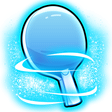Double bouncing serves - how to
Serving
Andrew Pape Asked 13 years ago
Hi Alois,
I've watched your double-bounce serve video. You pointed out the danger zone of where not to serve. The zone seems to be a bit beyond the middle of the table. For the double-bounce service, your advice is that the ball should land about mid-table. The Donic training dvd has a section on attacking the "1/2 long ball.", which presumably is mid-distance. I've watched the top players and found that when they serve to roughly the middle, they don't get attacked. I'm wondering how far (in table depth) is the ideal double-bounce serve in relation to an attackable serve? It seems that it's all a matter of millimetres. It would be good if you could supply a rough measurement, like how you've done with pieces of paper. I could then use paper and have a better idea of how well I'm going without a partner. I often find my training partner murdering my serves when to me they look like what the top players are doing, and I wonder what's gone wrong!
When practicing by myself I can't judge just how far the "almost second bounce" is over the end, unless the ball actually does bounce twice.
I guess when you factor in the service speed, things will get more complex.
You said that a slightly shorter ball (than mid-table) is best, so long as it's not too short. I think there must be a fine margin for error because when I watch the top-class players, sometimes the receiver plays safe, while other times he'll attack. I assume the receiver can tell the difference between a few millimetres. Any ideas?
Cheers,
Andrew.
 Alois Rosario Answered 13 years ago
Alois Rosario Answered 13 years ago
Hi Andrew,
You do need to just watch the result of what you are doing, which is the best way to learn the length that you need to serve.
As a guide I could say that the paper should be placed around one bat length from the net.
There is a very fine margin for error when serving and that is why it takes so long to master. Slightly long and it will be attacked, too short and it can be flicked easier or go into the net.
You should also consider the height of the ball over the net. This make a big difference to the effectiveness of the serve. Perhaps you can construct a string over the net like in our lesson on Keeping The Ball Low.
The better players can see the difference between those few millimetres and also the difference of the spin to be able to attack the balls that fall in their hitting zone. Sometimes the server may have too much deception and the receiver will be able to tell straight away the spin on the serve. The receiver will play more conservatively in this situation.
Recommended Video
Pendulum Serve
The pendulum serve is the most popular serve in all of Table Tennis. In this lesson we teach you the important principles and how to vary the serve between backspin, sidespin and topspin.
Watch NowNo comments yet!
Become a free member to post a comment about this question.